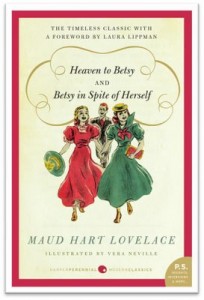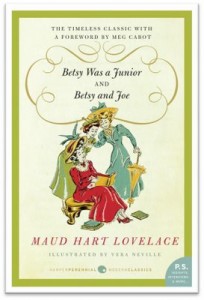Betsy and Tacy Go Over the Big Hill
The Betsy-Tacy reissues are out! And just in the nick of time: my old copies are about to fall apart from an abundance of love.
Over the next few weeks, a number of bloggers will be sharing their enthusiasm for the books of Maud Hart Lovelace in the Betsy-Tacy Book Blog Tour. Of course, my own enthusiasm has been spilling all over this blog for the past many weeks. I am tickled pink to see these books back in print. (I’ve been sitting here searching for the right adjective for “books” in that sentence: wonderful? delightful? important? fabulous? life-affecting? Everything sounds hackneyed or overused, but they’re all true.)
This week I reread my favorite of the “young” Betsy books.
(The series divides neatly into the young books—the first four titles, during which Betsy grows from age 5 to 12—and the older books, one for each year of high school, plus Betsy’s year abroad, and the year of her wedding. There are also a few related titles: Winona’s Pony Cart, another “young” book, and two older ones: Carney’s House Party and Emily of Deep Valley, which you know I adore.)
 Betsy and Tacy Go Over the Big Hill, the third book in the series, is one of those books that stays with you a long time. Snippets and images from Big Hill pop into my head all the time, especially when I’m witnessing quarrels between my daughters—a great deal of the plot centers on a disagreement between Betsy-and-Tacy and their older sisters, Julia and Katie. Like so many of the childhood events that weigh heavily on small shoulders, this quarrel over who is to be the Queen of Summer—which begins lightheartedly but turns tense and ugly—is deeply distressing to ten-year-old Betsy, who is torn between angry frustration and a desire to put things right with her beloved and much-admired sister. Lovelace’s sensitivity and good humor are in full force as Betsy and the other girls struggle to find their way out of the mess.
Betsy and Tacy Go Over the Big Hill, the third book in the series, is one of those books that stays with you a long time. Snippets and images from Big Hill pop into my head all the time, especially when I’m witnessing quarrels between my daughters—a great deal of the plot centers on a disagreement between Betsy-and-Tacy and their older sisters, Julia and Katie. Like so many of the childhood events that weigh heavily on small shoulders, this quarrel over who is to be the Queen of Summer—which begins lightheartedly but turns tense and ugly—is deeply distressing to ten-year-old Betsy, who is torn between angry frustration and a desire to put things right with her beloved and much-admired sister. Lovelace’s sensitivity and good humor are in full force as Betsy and the other girls struggle to find their way out of the mess.
But in the book’s opening, there is no hint of a storm on the horizon.
Oh, Betsy’s ten tomorrow
and then all of us are ten!
We will all be ten tomorrow,
We will all be ladies then.
Who can forget the fun of that opening scene! Tib turned ten in January, and Tacy was ten in March, but with Betsy lagging behind—she’s an April birthday—the others are too polite to make a big deal about having reached such an advanced age. Now it’s the day before the long-awaited April date, and the three friends are ready to put childish things like parades behind them and commence being ladies, prinking their little fingers over tea and expanding their vocabulary to include mature words such as “prefer” and “indeed.” And with the sixteen-year-old King of Spain making a stir in all the papers, it is inevitable that such sophisticated persons as Betsy and Tacy will decide it’s high time they fell in love. It’s a bewildered Tib, they decide, who ought to marry him—after all, her new accordion-pleated dress is fit for a queen. Alas, she is not of “the blood royal,” and the girls feel compelled to pen a letter explaining to the young king why the marriage cannot take place. That’s what sophisticated ladies would do, you know.
In the first two books, we got to know Betsy, Tacy, and Tib in the cozy setting of their small-town neighborhood: their kitchens, their yards, their school, and the gentle, grassy slope of the Big Hill that rises beyond Betsy and Tacy’s houses. Now that they are such grown-up young ladies, the trio of ten-year-olds ventures beyond the crest of the hill all alone for the first time. The adventure that meets the girls on the other side is wholly unexpected and unexpectedly thought-provoking.
Here in Betsy’s beloved Deep Valley, Minnesota, we expect to meet folks like the kindhearted Scandinavian neighbor, Mrs. Ekstrom, Tacy’s bustling Catholic family, and Tib’s proud German mother. What we don’t, perhaps, expect to find in this turn-of-the-20th-century small Midwestern town is a thriving community of Lebanese immigrants—refugees from religious persecution, recently arrived in America and proudly working toward American citizenship.
The community called “Little Syria” in the Betsy-Tacy books is, like most of the events in this series, based on real people. Just over the hill from Mankato, Minnesota (Deep Valley in the books) was a village called Tinkcomville, named after its founder, James Tinkcom. Tinkcom bought the land in 1873, expecting to sell it in lots for development, but it turned out to be too far from town to appeal to most Mankato folks. Finally, in the 1890s, he sold the lots to a group of immigrants from Lebanon. In Big Hill, Tinkcom—that is, “Mr. Meecham”—is described as a reclusive and curmudgeonly sort, living in a big brick house near Little Syria and not mingling overmuch with the Deep Valley folks. However, there’s a place in his heart for anyone who befriends the good people of Little Syria—which is exactly what Betsy, Tacy, and Tib find themselves doing when their last pre-double-digits parade takes them over the crest of the Big Hill to a slope overlooking the village.
The girls’ shock at having walked so far alone dissipates quickly when they remember how grown-up they are now, on this eve of Betsy’s big day.
“Well, I’m surprised!” said Tacy. “I never knew we could walk to Little Syria.”
“I’m not surprised,” said Betsy.
“You’re not?” asked Tacy.
“No,” said Betsy. “Remember I’ll be ten tomorrow. It’s the sort of thing we’ll be doing often from now on.”
“Going to other towns?” asked Tacy.
“Yes. Little Syria, Minneapolis. Chicago. New York.”
“I’d love to go to New York and see the Flatiron Building,” said Tacy.
Tib looked puzzled.
“But Little Syria,” she said, “is just over our own hill. We didn’t know that it was. But it is.”
“Well, we certainly didn’t find it out until today,” said Betsy.
“We certainly never walked to it before,” said Tacy.
“That’s right,” admitted Tib.
This sunny confidence is what makes Betsy irresistible to the Deep Valley small fry—and to generations of readers. (In the high-school books, her confidence will waver a little, and she is sometimes prey to a kind of listless depression—but this, too, is part of Betsy’s appeal. She’s a real girl, imperfect, wrestling with moods and passions and uncertainties, trying to figure out who she is and who she wants to be, and sometimes puzzled by how vehemently her family and friends declare she’s just right just the way she is, imperfections and all.)
One day Betsy will roam the Great World, but right now, poised atop the Big Hill and at the brink of ten, the path before her is full of adventures she—yes, even she of the big imagination—could never have imagined. First there is the encounter with Naifi, one of the Syrians, “a little girl so strange she seemed to have stepped out of one of Betsy’s stories.” Strange, that is, to the eyes of a Deep Valley girl who has never seen a child with earrings and a “long skirt, like a woman’s,” speaking a language Betsy, Tacy, and Tib cannot understand. The language of picnics is universal, however, and over their different kinds of bread, a friendship is born. Before long the Deep Valley trio will find themselves springing into battle to defend their new chum, venturing into houses where the grandpas smoke hubble-bubble pipes and the grandmas pound lamb with mallets, and, eventually, learning from these new neighbors a deepened pride and appreciation for what it means to be an American.
And then, of course, there’s that sisterly quarrel still to patch up. Who will be the Queen of Summer? And whatever became of the letter Betsy, Tacy, and Tib sent to the King of Spain?
Would you believe I was supposed to write about two books in this post? I could easily go on yapping for several more pages about Big Hill. Could spend about a week mining the riches of Betsy and Tacy Go Downtown. But this post is already a ridiculous 1400 words long. So let me ask you: Which one do you like best—Big Hill or Go Downtown? (I mean: the Christmas shopping, the play, the delicious Mr. and Mrs. Poppy, the horseless carriage! The three telephone calls! Oh!)
Here’s a list of the entire Betsy-Tacy series in chronological order.
 Several Betsy-Tacy fan club chapters around the country are hosting special events to celebrate the reissue of the books. If you’re in the vicinity of any of these—I’m jealous!
Several Betsy-Tacy fan club chapters around the country are hosting special events to celebrate the reissue of the books. If you’re in the vicinity of any of these—I’m jealous!
9/30 Aliso Viejo, CA, at the Aliso Viejo Library
10/3 Mankato, MN, at the Betsy Tacy Houses
10/3 Mesquite, TX, at Borders
10/23 Bainbridge Island, WA, at the Library (This date is tentative.)
11/7 Highland Village, TX, at Barnes and Noble
11/8 St. Paul, MN, at the Red Balloon Bookshop
4/17/10 Dallas, TX, at the Dallas Heritage Museum

Related posts:
Heaven to Betsy! High-school-and-beyond books being reissued! (Sept 2009)
Betsy and Tacy Go Over the Big Hill
The Betsy-Tacy Songbook
Interview with Mitali Perkins, Jennifer Hart, and me about Maud’s books
Betsy-Tacy booksigning at ALA Midwinter
Photos of my visit to the real Deep Valley, as chronicled by Margaret in Minnesota
Why I love Carney
Why I love Emily
A Reader’s Guide to Betsy-Tacy




